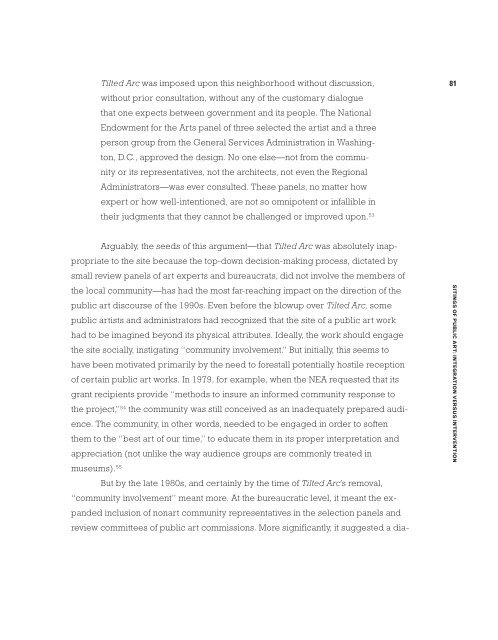ONE PLACE AFTER ANOTHER - Monoskop
ONE PLACE AFTER ANOTHER - Monoskop
ONE PLACE AFTER ANOTHER - Monoskop
Create successful ePaper yourself
Turn your PDF publications into a flip-book with our unique Google optimized e-Paper software.
Tilted Arc was imposed upon this neighborhood without discussion,<br />
without prior consultation, without any of the customary dialogue<br />
that one expects between government and its people. The National<br />
Endowment for the Arts panel of three selected the artist and a three<br />
person group from the General Services Administration in Washington,<br />
D.C., approved the design. No one else—not from the community<br />
or its representatives, not the architects, not even the Regional<br />
Administrators—was ever consulted. These panels, no matter how<br />
expert or how well-intentioned, are not so omnipotent or infallible in<br />
their judgments that they cannot be challenged or improved upon. 53<br />
Arguably, the seeds of this argument—that Tilted Arc was absolutely inap-<br />
propriate to the site because the top-down decision-making process, dictated by<br />
small review panels of art experts and bureaucrats, did not involve the members of<br />
the local community—has had the most far-reaching impact on the direction of the<br />
public art discourse of the 1990s. Even before the blowup over Tilted Arc, some<br />
public artists and administrators had recognized that the site of a public art work<br />
had to be imagined beyond its physical attributes. Ideally, the work should engage<br />
the site socially, instigating “community involvement.” But initially, this seems to<br />
have been motivated primarily by the need to forestall potentially hostile reception<br />
of certain public art works. In 1979, for example, when the NEA requested that its<br />
grant recipients provide “methods to insure an informed community response to<br />
the project,” 54 the community was still conceived as an inadequately prepared audience.<br />
The community, in other words, needed to be engaged in order to soften<br />
them to the “best art of our time,” to educate them in its proper interpretation and<br />
appreciation (not unlike the way audience groups are commonly treated in<br />
museums). 55<br />
But by the late 1980s, and certainly by the time of Tilted Arc’s removal,<br />
“community involvement” meant more. At the bureaucratic level, it meant the ex-<br />
panded inclusion of nonart community representatives in the selection panels and<br />
review committees of public art commissions. More significantly, it suggested a dia-<br />
81<br />
SITINGS OF PUBLIC ART: INTEGRATION VERSUS INTERVENTION

















